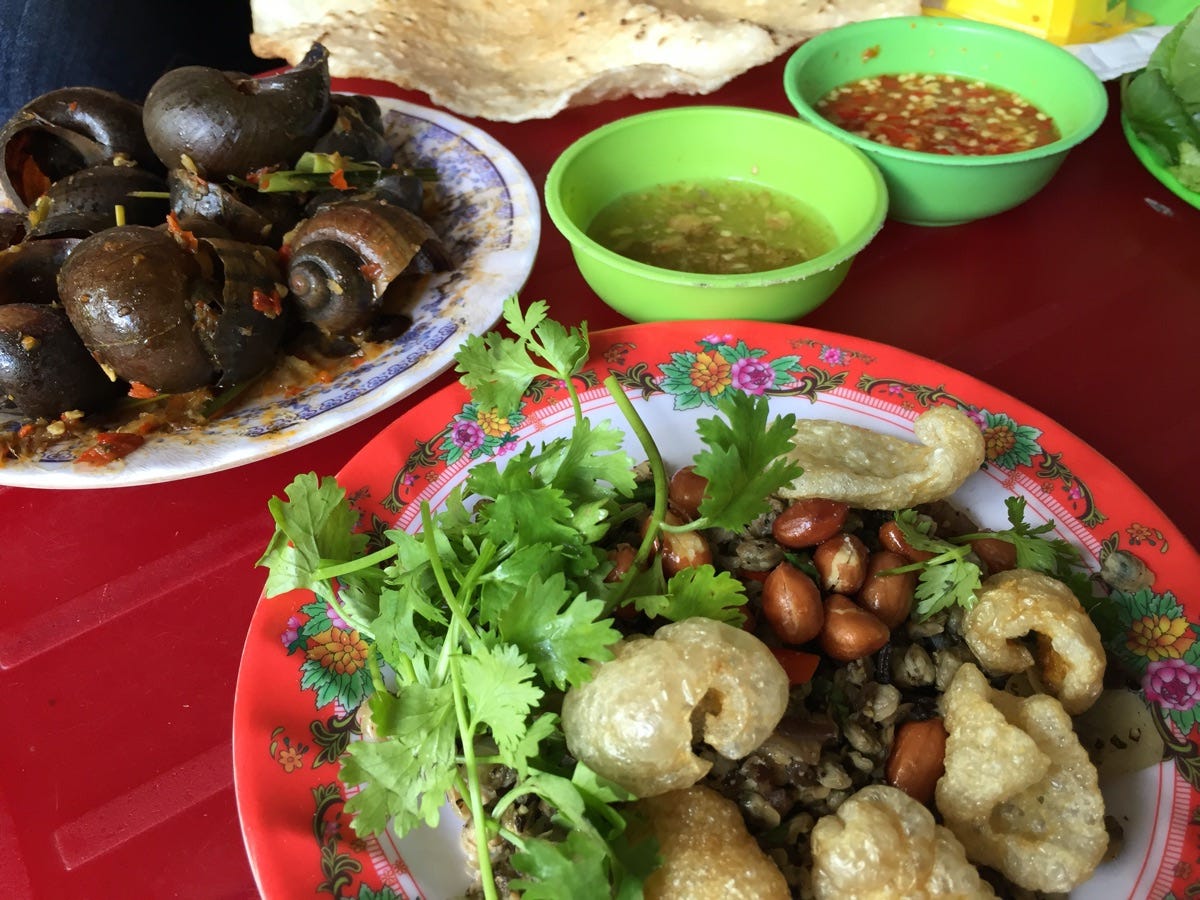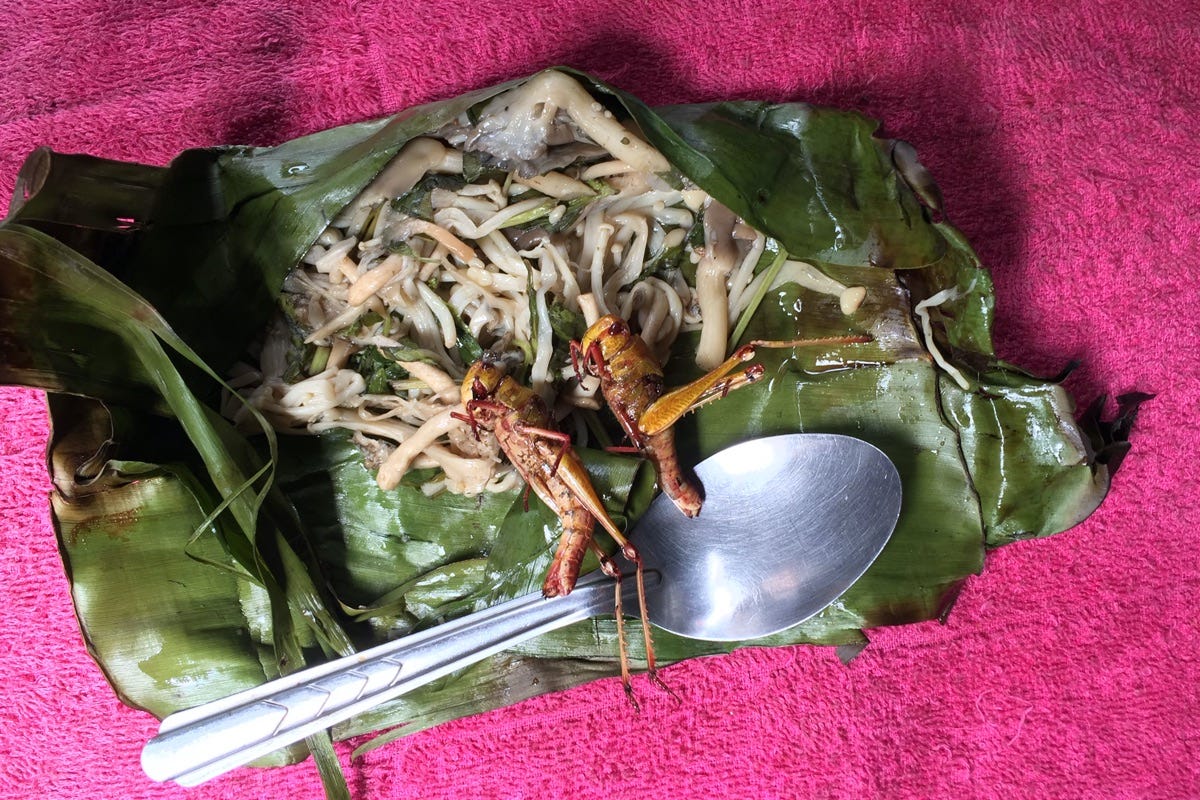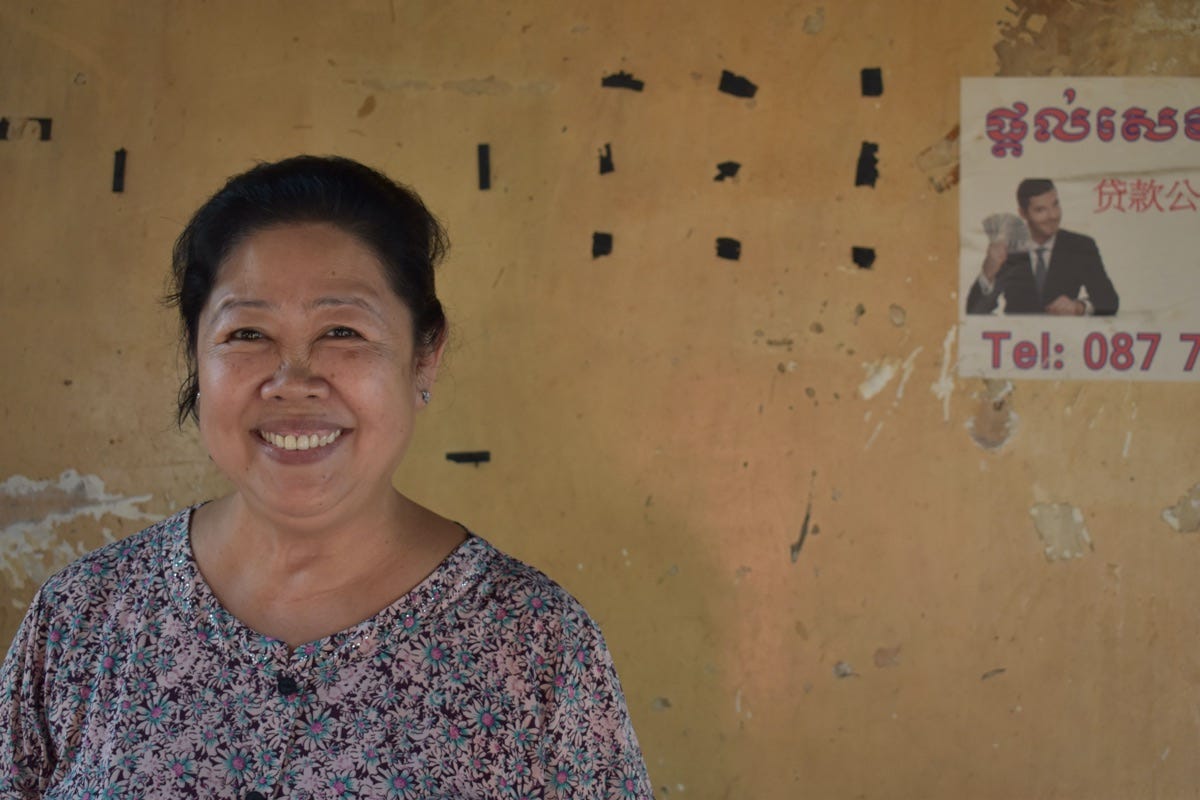It doesn’t matter if you’re travelling, or at home, everyone eats. If you’re at home, think about the meals you have had over the last few days. What does what you ate and drank say about you, your culture and the country you are living in?
A CNN video on Hanoi Street Food Tours.
I’m Australian, so Vegemite (not Marmite!) is on my list. The salty black paste would be a feature in the diets of many Australians, both at home and abroad. Who hasn’t been in a restaurant for breakfast and seen another guest sneak out a jar of the black gold? Odds on they’re Australian.
If we have foreign guests staying and they see the Vegemite, they often ask to try it. I hand over the jar, watch them layer it on like peanut butter, and wait for the inevitable.
“Oh my god what is wrong with you people?!”
“You have to scratch it on mate.”
Yes, food, along with oxygen and water, is an essential of life. It is also handy though for socialising.
The chance of me finding this snail place outside Hue without a guide was exactly zero. Photo: Stuart McDonald.
When I lived in London, if I was going to meet up with Londoners, we would meet at the pub. Always. When I go to Bangkok, if I’m catching up with Thai friends, we don’t meet at the pub—we meet somewhere where food is the focus.
Curious about this, I asked a Thai friend who I often meet when in Bangkok. I could write an entire Couchfish edition on her reply, but the condensed version goes like this:
“A traditional way Thais greet one another is to ask “have you eaten yet?” When people gather, it always needs to be somewhere to do with food. We’re just into feasting. You could say we’re the Hobbits of Southeast Asia as, like the hobbits in Lord of the Rings, we love to eat five times a day.
Bangkok has become a place driven by capitalism where the rich suck profits out of the rest of us. This comes from the very top. From the monarch, to the government, to the big organisations, and finally to the small ones.
We have no Central Park in the way New York does—there are few places to walk or read books, or picnic on a nice day. Suan Lum is more for exercising, though some do socialise there. Free public spaces for leisure, where you can walk or sit with friends to catch up are limited. Instead, we humans of Bangkok spend our time in malls and restaurants, where the elite can exploit us.
In the end, we eat our bitterness away.”
Like I said, you can learn a lot as soon as you start talking about food.
Would this Bangkokian have told me his story without the help of Chin Chongthong? No. Photo: Stuart McDonald.
Food is not simply food. It is a window into, and a learning opportunity about, other people, their culture and country. Get it wrong—eat pad thai with chopsticks, or say durian smells like a corpse, at your peril. When people feel their foods are being badly–reported, they let you know.
All the above are reasons why I suggest first time arrivals to a country do something food related early on. It could be a cooking course or a market tour, or, my personal favourite, a street food tour.
Foreign food can be intimidating. It isn’t only a question of what it is, but also how do I eat it, when do I eat it, what should I pay for it?
Food may mimic art, but still often needs explanation. In this case, by Chin. Photo: Stuart McDonald.
Chin Chongthong, runs Chili Paste, a small food and cultural tours agency in Bangkok. For Chin it is very much about learning.
“On a food tour guests can try a full range of Thai flavours. They can learn about different ingredients and food’s regional differences across Thailand. Also some of the history, about the influences from Chinese or Lao or Mon people. What is Thai food? It’s a mix of so many different influences over many hundreds of years. ”
To a point a food tour is a contrived journey—more often than not, every stop is pre–planned with an experience in mind. It could be that the venue offers an exemplary serving of a dish. Another, a particularly “local” experience. Yet another because the vendor is personable and fun or has an interesting story. All boil down into what eating can be—enjoyable and educational.
A guide and I spend a few hours exploring a single city block in Ho Chi Minh City. This was a highlight. Photo: Stuart McDonald.
The first time I went to Vietnam, I knew nothing about the food. I ate pho and nem day in day out, partly because it was all I could say, but also because it was all I knew. At the end of the trip, in Ho Chi Minh City, I stayed at Miss Loi’s. She was so outraged at my limited diet she sent me out with one of her daughters to “eat properly”.
Van Cong Tu of Hanoi Street Food Tours supports this idea of discovering the unknown, saying:
“I think it’s primarily about having a tasty experience at places a traveller may not be able to find themselves. Equally it’s about giving them a skill set to navigate the territory solo. Take the fear away a bit. Culture and traditions around food are a great way to orientate a traveller in a new place through a lens of food.”
Every trip I’ve made to Vietnam since that first time, I’ve built on my food experience. Find a local who is into their food and go eat. Sometimes these are tours, sometimes more casual affairs. Food blends with so many things.
Eating my way through Malang—and what is left of its heritage buildings. Photo: Stuart McDonald.
In Malang in East Java I did a combined architecture and food walk. As with all good food tours, every pause, every sit down to eat, wasn’t only about the food. It was also about the people who prepared it, those who ate it, and, in this case, the buildings it all happened within.
Then there are the guides. These are the people who pull all the threads together over a steaming bowl.
I asked Vanarith, the Phnom Penh food guide I wrote about in Friday’s paid Couchfish, about his early life. He said:
“I am from Koh Kong province and I was born into a banana leaf.”
I thought he was joking, that it was a turn of phrase, except it wasn’t. When the other guest and I realised this, it was like when you meet a fireman for the first time. Our questions came thick and fast. I learned a lot—not just about Vanarith, but also what life is like when you are born into a banana leaf.
“Not for vegetarians,” laughed Vanarith. Photo: Stuart McDonald.
Back in Vietnam, a Vietnamese friend in Ho Chi Minh City offered to show me around Sa Dec, a cute Mekong Delta town. She was not a professional guide by any means, but she loved food and Sa Dec was her home town. What started as a bit of a whim, turned into one of my most memorable half day eating excursions.
This was in part because she knew great places to eat. There was more though—growing up there, she knew the people behind many of the places we ate at. I heard owner’s stories, including where in Australia their kids were studying.
Doing a food walk is an ice breaker. It moves a national cuisine from intimidating to slightly less so. It makes the people a little less mysterious and foreign. You learn something about them and they something about you.
Smiles always help—and more often than not are returned. Photo: Stuart McDonald.
The language barrier though can make doing this solo, tricky. Lina Goldberg of Phnom Penh Food Tours, highlights this, saying:
“...taking a food tour is a delicious way for visitors who don't speak the language to connect with local culture.”
Outside of tours, I’ve always handled this challenge with the tried and tested “point at food” approach. I’ll finish with a quick tale.
I was in Cao Lanh, a little–visited province in Vietnam’s Mekong Delta. Out looking for dinner I sat down at a jammed beer and food place. The menu was only in Vietnamese and staff spoke no English. I pointed to what they were having at the next table, and gestured that I’d like that please.
The dish in question. Photo: Stuart McDonald.
The dish came, it was a hotplate of beef and vegetables along with these pasty yellow, egg–like things. I wasn’t sure what they were and, signing, I tried to ask the next table what they were. They were drunk, but through their gesturing I deduced they meant testicles. You can imagine the gestures right?
I’m not great on testicles, so I took a photo of the dish and messaged it to above–mentioned Tu, asking what it was. The answer took me by surprise.
They were not testicles. Instead they were unlaid chicken eggs—removed from the inside of a slaughtered hen.
I’ve never in my life so wished I was eating testicles. The next table? We’re still friends on Facebook.


















